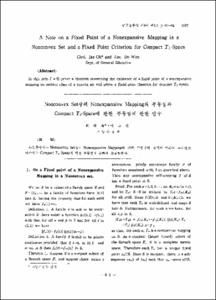네트워크 모형의 개체지향적 전산구현
- Alternative Title
- Computerization of the Network Model Using the Object-Oriented Programming
- Abstract
- 본 논문에서는 개체지향 프로그래밍 개념을 이용하여 네트워크 모형의 전산 구현 통합패키지를 개발하였다. 네트워크 모형을 표현하기 위하여 내부적으로 단일 연결리스트를 채택하였다.
풀-다운 메뉴 방식을 이용하여 파일, 자료 입출력, 그리기, 문제선택 메뉴를 구성하였다. 자료입력의 경우 마우스를 이용한 입력, 고밀도 네트워크에 대한 파일 입력, 저밀도 네트워크에 대한 파일 입력의 3가지 방식을 제시하였다. 현실감을 높이기 위해 모형을 그래픽으로 나타낼 수 있도록 하였다. 또한 사용자가 자신의 환경에 따라 선택이 가능하도록 고밀도 및 저밀도 자료형식으로 저장이 가능하도록 하였다. 응용 예를 위하여 최단경로나무문제, 최소걸침나무문제, 최대흐름문제의 해법을 첨가하였으며, 사용자는 자신의 문제에 대한 해법을 서브루틴으로 추가할 수 있도록 ?臼눼?.
개체지향개념을 이용하였기 때문에 네트워크 모형을 쉽게 확장할 수 있으며 프로그램을 재사용할 수도 있다. 따라서 사용자는 네트워크 모형을 전산구현하는데 드는 노력을 대폭 경감시킬 수 있다.
An integrated computer-package for the network model is developed, where the network model is implemented using object-oriented programming. Node object, arc object and network object are defined a user-defined objects. Singly linked list is adopted as the internal data structure for network representation.
All works are designed to be implemented through the pull-down menu. The main menu consists of FILE, INPUT TYPE, DRAWING, and PROBLEM SELECTION. Three methods are suggested for data input: mouse input, file input for dense-type data, and file input for sparse-type data. The model can be displayed graphically for the sense of reality. It can be stored in both dense-type and sparse-type data format, which enables the user to fit the model to his/her environment.
Shortest path tree problem, minimum spanning tree problem, and maximal flow problem are applied for illustrations. Since the network model is realized using the object-oriented concept, the user can apply any problem with its own subroutine.
The object-oriented programming gives the benefit of modifying or expanding the model easily and reusing the program. As a result, the user can dramatically save time and efforts for implementing the network model.
An integrated computer-package for the network model is developed, where the network model is implemented using object-oriented programming. Node object, arc object and network object are defined a user-defined objects. Singly linked list is adopted as the internal data structure for network representation.
All works are designed to be implemented through the pull-down menu. The main menu consists of FILE, INPUT TYPE, DRAWING, and PROBLEM SELECTION. Three methods are suggested for data input: mouse input, file input for dense-type data, and file input for sparse-type data. The model can be displayed graphically for the sense of reality. It can be stored in both dense-type and sparse-type data format, which enables the user to fit the model to his/her environment.
Shortest path tree problem, minimum spanning tree problem, and maximal flow problem are applied for illustrations. Since the network model is realized using the object-oriented concept, the user can apply any problem with its own subroutine.
The object-oriented programming gives the benefit of modifying or expanding the model easily and reusing the program. As a result, the user can dramatically save time and efforts for implementing the network model.
- Issued Date
- 1997
- Type
- Research Laboratory
- Alternative Author(s)
- Koh,Jae-Moon; Seo,Joon-Yong
- Publisher
- 공학연구논문집
- Language
- kor
- Rights
- 울산대학교 저작물은 저작권에 의해 보호받습니다.
- Citation Volume
- 28
- Citation Number
- 1
- Citation Start Page
- 95
- Citation End Page
- 111
- Appears in Collections:
- Research Laboratory > Engineering Research
- 파일 목록
-
-
Download
 000002025170.pdf
기타 데이터 / 99.04 kB / Adobe PDF
000002025170.pdf
기타 데이터 / 99.04 kB / Adobe PDF
-
Items in Repository are protected by copyright, with all rights reserved, unless otherwise indicated.